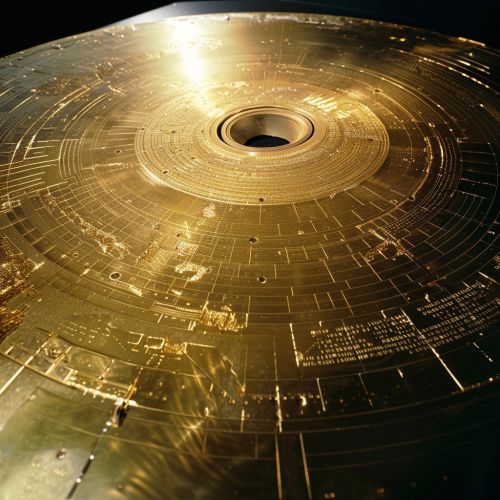Golden Record
Overview
The Golden Record refers to the two phonograph records that were included aboard the Voyager 1 and Voyager 2 spacecraft launched by NASA in 1977. These records contain sounds and images selected to portray the diversity of life and culture on Earth, intended for any intelligent extraterrestrial life form or future humans who may find them.
Historical Context
The concept of the Golden Record was developed during the Cold War era, a time characterized by significant advancements in space exploration. The Voyager program was part of NASA's mission to explore the outer planets, and the inclusion of the Golden Record was a symbolic gesture of peace and a message from humanity to the cosmos.
Development and Content
The Golden Record was curated by a committee chaired by Carl Sagan, an American astronomer and astrophysicist. The content of the records includes 115 images, a variety of natural sounds (such as those made by surf, wind, and thunder), musical selections from different cultures and eras, spoken greetings in 55 languages, and printed messages from then-U.S. President Jimmy Carter and U.N. Secretary-General Kurt Waldheim.
Images
The images on the Golden Record cover a wide range of subjects, including scientific diagrams, human anatomy, and everyday life on Earth. These images were encoded in analog form and were intended to be decoded by any intelligent extraterrestrial beings who might come across the spacecraft.


Sounds
The sounds on the Golden Record include a variety of natural noises, such as those made by animals, as well as human-made sounds like the firing of a rocket and the hum of a car engine. These sounds were chosen to provide a comprehensive auditory snapshot of life on Earth.
Music
The musical selections on the Golden Record span a wide range of genres and cultures. They include classical pieces by Johann Sebastian Bach and Ludwig van Beethoven, traditional music from various cultures, and contemporary tracks like Chuck Berry's "Johnny B. Goode."
Technical Specifications
The Golden Record is a 12-inch gold-plated copper disk. The records are encased in aluminum jackets, along with a cartridge and a needle. Instructions, in symbolic language, explain the origin of the spacecraft and indicate how the record is to be played. The records play at a speed of 16⅔ revolutions per minute (rpm).
Scientific and Cultural Impact
The Golden Record serves as a time capsule and a message in a bottle, representing humanity's attempt to communicate with extraterrestrial life. It has also inspired numerous discussions and debates about the nature of human civilization and our place in the universe.
Preservation and Legacy
The Voyager spacecraft are currently in interstellar space, and the Golden Records are expected to last for over a billion years. Their legacy continues to influence popular culture and scientific thought, inspiring projects like the Arecibo message and the Breakthrough Starshot initiative.
